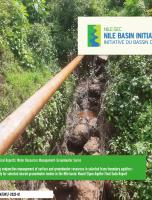Abstract
The Nile Basin Initiative (NBI) Secretariat (Nile-Sec) had conducted a Strategic Water Resources Analysis (SWRA) in 2015 with the aim of developing various sustainable options for satisfying the growing water needs in the Nile riparian countries, and subsequently to mitigate current and future water stress. The NileSec has recently identified data gaps in its previous SWRA study, particularly due to the lack of integration economic modeling of water use to assess the value of irrigation water. A limitation of the SWRA study was that the impact of increased water productivity on food security and water use was not analyzed across the basin. Furthermore, the SWRA assessment did not analyze the impact of optimal planning of cropping patterns on specific climate and soil conditions.
This second phase study was commissioned with the objective of refining the 2015 estimates of agricultural water demand/use and projections. It is envisaged that this study will support sustainable and efficient investment planning to meet the growing water demand in line with the Nile-Sec’s plan. The phase II study consists of six components. This report refers to Component-I of this phase II project: ‘Contribute to improving baseline irrigation water demand and actual use’. This component was required to review the data and results of irrigation water demands estimation from the first phase of the SWRA study and identify areas for further refinement and improvement. This report aims to inform agricultural water management policies by presenting water saving options, such as adoption of improved irrigation technologies and optimization of cropping patterns across the basin among others. The compilation of the baseline database was based on a desk-based review of secondary information. The sources of information include existing NBI data, master plan of member countries, study documents and expert inputs




